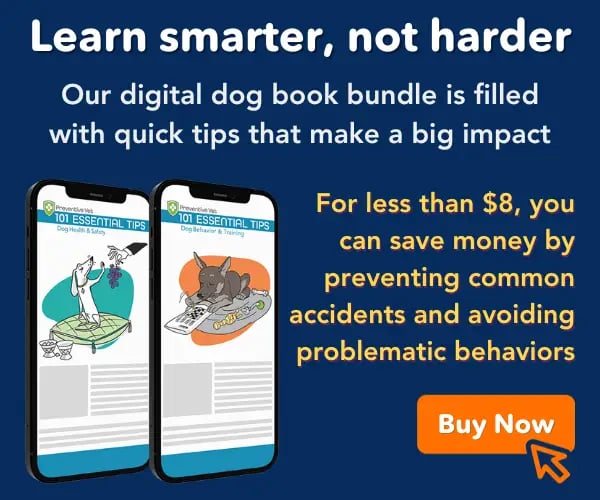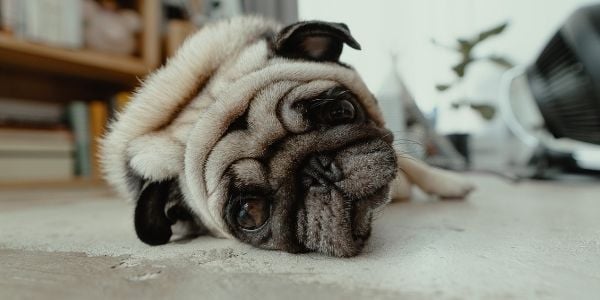 Food bloat (aka gluttony bloat) in dogs is uncomfortable.
Food bloat (aka gluttony bloat) in dogs is uncomfortable.
The symptoms of food bloat are different than bloat due to gastric dilatation and volvulus (GDV). And while not as serious as GDV, food bloat, if left untreated, can be a painful condition requiring veterinary care and possibly surgery.
Causes of Food Bloat
Food bloat is just what it sounds like. A dog eats an exceptionally large amount of food in a short period of time.
The stomach fills with air and food, causing it to become so enlarged that it stretches beyond what is normal and causes pain and discomfort due to the stretching of the stomach's pain receptor. It may be from eating dog food, cat food, human food, treats, or even getting into the garbage.
A "large amount" of food will vary depending on the size of the dog. A small dog, like a Pug or Chihuahua, can bloat from eating 2–3 times their daily intake. A large breed dog, like a Lab or Great Dane, may need to ingest 3–5 times their normal food intake to cause their stomach to bloat.
Signs of Food Bloat Are Similar to Symptoms of Gastric Dilatation and Volvulus (GDV)
The “evidence” may be just the thing you need to know something is up and that your dog got into food they shouldn’t have. Coming home to an open pantry door, a missing roast off the counter, or a bag of dog food with holes in it – with a “guilty” looking pooch nearby – is usually the first sign that something is going on. Your dog’s stomach may look swollen and feel hard, or their ribs may appear to stick out further than normal. The signs of food bloat are similar to GDV:
- Retching or trying to vomit unsuccessfully
- Panting
- Restlessness
- Drooling
- A swollen, hard abdomen
- Chest may appear swollen or “stick out” more
- Lack of energy
- Lack of appetite
- Increased (or decreased) water consumption
- Painful acting (see signs of pain)
- Abdominal pain
- Racing heart rate (see how to check your dog's heart rate)
- Shortness of breath
- Vocalizing or whining
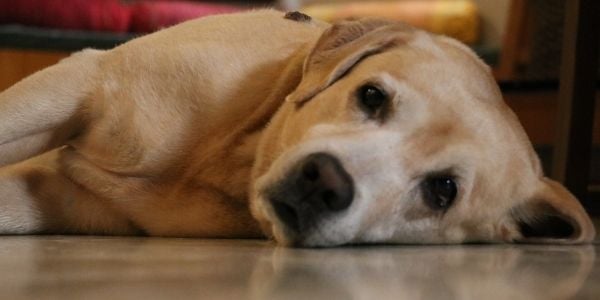
Questions? To chat with a veterinarian about your dog's bloated stomach, Click here
If you see any of the signs listed above in your pup, it is important to seek veterinary care to determine if the symptoms are from food bloat or GDV. If left untreated, food bloat can lead to GDV because the stomach can fill with air and then rotate (another term for it is torse/torsion). This is even more probable for deep- or barrel-chested dogs, like Great Danes, Weimaraners, Boxers, and many more breeds listed in our Cause of GDV/Bloat article.
Any dog can use their ultra-sensitive nose and take advantage of the opportunity to eat as much as they can. Some dogs are more food motivated than others, like Labrador and Golden Retrievers. And giant breed dogs are known to easily swipe items off counters, like entire loaves of bread or trays of cupcakes. But don’t count out the little dogs, like Chihuahuas or Beagles. Both can get into pantry doors left ajar or tear open food bags that have been left out. A bored dog looking for something to do can also be a recipe for disaster. Lastly, dogs that are on weight-restricted diets due to being overweight are also more likely to gorge when they find a readily accessible food source.
What Your Dog Ate Might Be of Concern for Stomach Bloat
Dogs eating items from the garbage have rarely resulted in food bloat. However, many dangerous things are lurking in indoor and outdoor trash bins. Chicken, pork, or steak bones can pose a threat for intestinal obstruction or perforation. Plastic baggies that are often laced with leftover food and crumbs can cause an intestinal obstruction or result in suffocation. And other fatty foods found in the garbage or on the counter, like sticks of butter, may not cause bloat, but your dog can develop pancreatitis.
So even if your dog doesn’t look bloated, you should still seek veterinary care to avoid other issues that can develop later.
NEVER try to induce vomiting unless your veterinarian or emergency clinic has advised you to do so.
Inducing vomiting increases the chances of your pet choking and aspirating (inhaling the vomit into their lungs), which will lead to pneumonia and additional complications. This is especially risky for brachycephalic breeds (flat-faced breeds), and weak or unconscious pets.
Do not induce vomiting in a dog that is already vomiting. It is also not safe to induce vomiting in pets with seizures or other neurologic conditions. Additionally, it is not recommended for pets with heart disease, a history of bloat, or those that have recently had abdominal surgery.
Hydrogen peroxide is typically used to induce vomiting and it is generally safe for dogs (never use it with cats). The veterinarian will guide you through the steps over the phone if they recommend you take this approach before going into the hospital.
For $5, you can connect with a veterinarian to discuss your dog’s stomach issue.
Connect now
Rates may differ for those residing outside the U.S. You'll have access to a vet for 7 days.
Treatment for Food Bloat
Once your dog is at the veterinary hospital, your doctor will do a physical exam, and an x-ray will be taken. Food bloat shows up as large amounts of food visible in the stomach. This helps distinguish it from GDV, which is usually just air in the stomach.
Please be aware that some items stolen from the trash, such as plastic bags or wraps, may not be visible on x-rays. Therefore, if your dog has gotten into the trash, additional imaging or surgery may be needed to determine the cause of symptoms.
Once GDV is ruled out, your vet may try to induce vomiting if the stomach is not overly distended. If successful, this usually provides prompt relief. Sometimes your pet may not vomit, and, in these cases, intravenous or subcutaneous fluids are administered, depending on how severe the bloat is. This will help keep your dog hydrated.
Note: If your dog’s stomach is overly extended, vomiting is contraindicated (strongly not recommended) since it can cause the stomach to potentially rupture.
Medications to speed gastric motility and help the stomach empty quicker may be given. Your pet may need to stay in the hospital so your vet can take follow-up x-rays to make sure the stomach is going down in size and the food is moving through the intestinal tract.
Pain medications are also given to provide relief from the discomfort as well as to help your dog relax.
In severe cases, but the dog is stable, stomach lavage (similar to stomach pumping) under anesthesia may be necessary in order to help remove food. Surgery is needed in cases where the food cannot be removed via stomach lavage, or a foreign object is suspected.
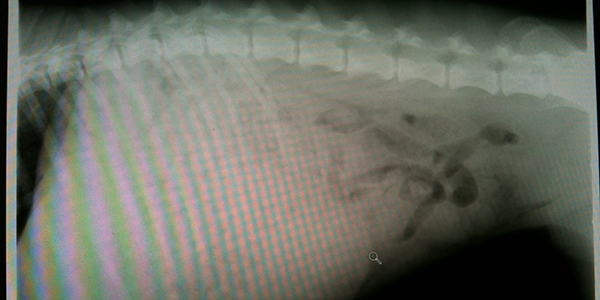
A bloated stomach from overconsumption of food will be very dilated (swollen) on an x-ray. This stomach (featured in the photo above) is FULL of digested food, which makes it difficult to see the other organs or intestines. Occasionally you may see some gas in the intestines, like in this x-ray that shows up as what appears to be snake-like black loops. Gas or air is black on an x-ray, whereas anything soft such as food or tissue, is grey, and bone is white. The AFTER photo below is what came out after the veterinary team induced vomiting.
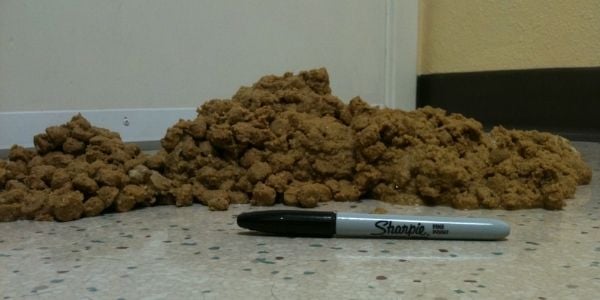
How to Prevent Food Bloat
Preventing food bloat takes a little bit of planning and attention to detail. Never assume that your dog cannot get into food bags, trash cans, or even push open the door to a pantry.
It is best to store your dog's kibble in a separate container other than its original bag. Put the container somewhere your dog cannot access.
The Vittles Vault is a Preventive Vet team favorite. They come in different sizes, are stackable, air-tight to keep kibble fresher longer, and are near impossible to chew through. They're easy to road trip with, too – keeping the kibble safe from your dog in the car.
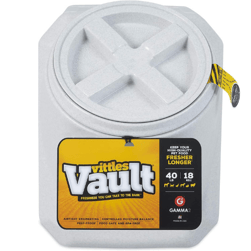 Gamma2 Vittles Vault Pet Food Container
Gamma2 Vittles Vault Pet Food Container
Buy on Chewy | Buy on Amazon
Make sure that your garbage cans are secured or dog-proof. However, a determined and curious dog can push over almost any trash can and find a way inside if they smell something delicious. For this reason, do not throw meat, food scraps, or bones in your kitchen garbage. Instead, put it in a secure outside trash bin so your pup cannot be tempted, or behind a secure door.
These magnetic "child-proof" locks work well on kitchen cabinets. Some of our teammates use them to keep pets out.
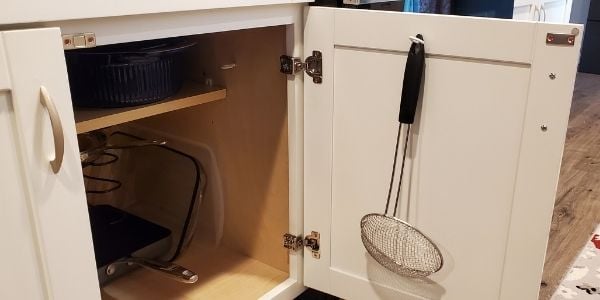
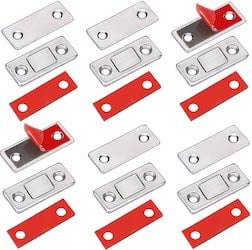
Jaiyi 6-pack Cabinet Door Magnets
Buy on Amazon
Our team also recommends these no-drill child safety straps. They can be used in a variety of places around the home.
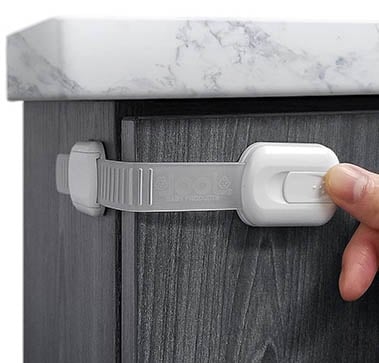
Jool Baby No-Drill Child Safety Straps
Buy on Amazon
Little-known danger lurking in garbage cans and on counters: chip and snack bags. Dogs can suffocate by getting their head stuck in a bag, seeking out the crumbs or leftovers in a Ziploc®. Even a 130 lb dog can't remove the bag once it's stuck. Learn more about pet suffocation and ways to prevent it.
Make sure treats like rawhides or dog biscuits are in secure cabinets or even outside in the garage if you have one. This goes for cat food and treats as well. Dogs love the smell and taste of cat food so take extra precautions to store this food in pet-safe containers in an area where your curious canine cannot get to it.
If something has to stay on the counter, make sure it's pushed as far away as your dog is tall. Although, some determined dogs have pushed chairs to the counter's edge to seek out the goodness! If jumping up on the counter is an ongoing hobby for your dog, check out these counter surfing tips and videos, to help you teach your pup that this is an unwelcome and dangerous behavior.
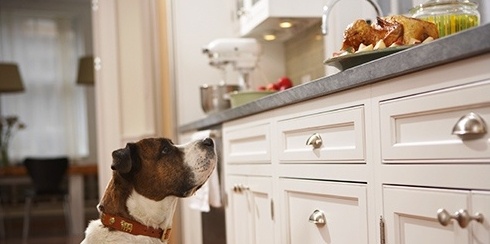
Luckily, food bloat is very treatable and does not always require hospitalization. It is still important to contact your veterinarian or after-hours emergency hospital if you think your dog has ingested a large amount of food or treats. Prompt advice and treatment from a veterinarian can make this condition treatable and provide your dog with quick relief.


